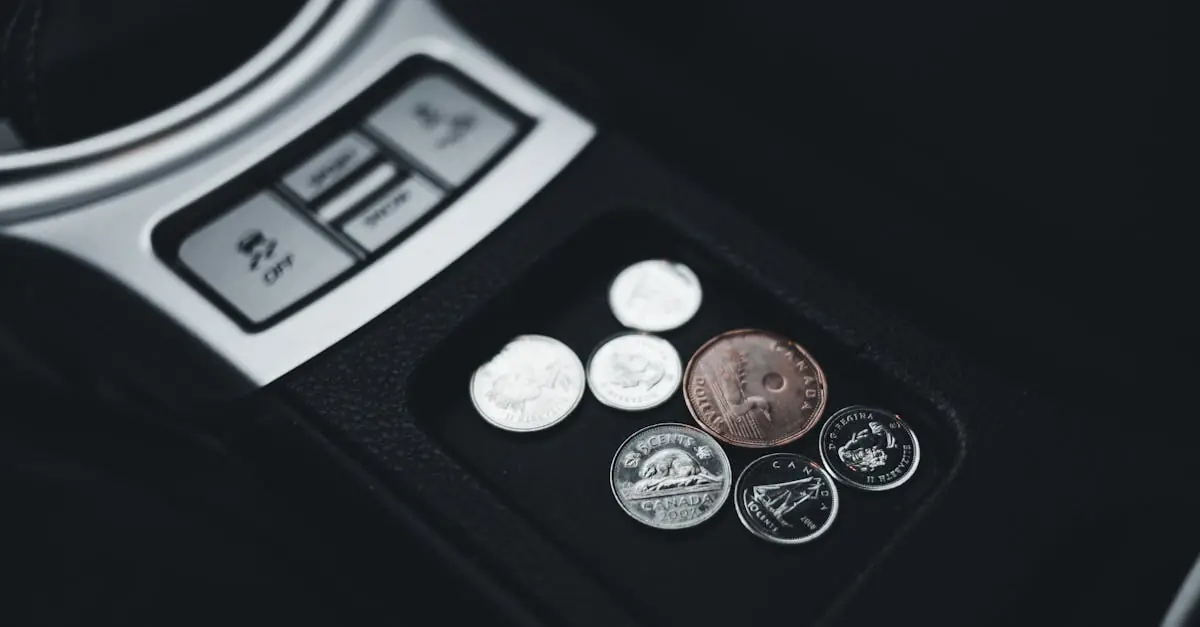Buying a car can feel like diving into a pool of uncertainty, especially when it comes to budgeting. One minute you’re dreaming of that shiny new ride, and the next, you’re staring at your bank account like it just told you a bad joke. But fear not! With a little planning and some savvy budgeting, that dream car can go from a distant fantasy to a reality parked in your driveway.
Table of Contents
ToggleUnderstanding Budgeting for a Car
Successful car ownership begins with understanding budgeting. Proper financial planning transforms the dream of owning a vehicle into reality.
Importance of Budgeting
Budgeting plays a critical role in car ownership. It helps assess overall financial situation, ensuring costs fit within income limits. Making informed decisions prevents overspending and minimizes financial strain.
Setting realistic expectations for monthly payments, insurance, and maintenance costs aids in creating a sustainable budget. Having a clear budget encourages saving for future repairs and upgrades, enhancing overall ownership experience.
Key Components of a Car Budget
Several components comprise a comprehensive car budget. Monthly car payment represents a significant expense, often dictated by loan terms and interest rates. Insurance costs introduce another vital aspect, varying based on coverage types and driving history. Maintenance expenses include routine services and unexpected repairs, which can arise at any time.
Fuel costs also add to the budget, influenced by vehicle efficiency and driving habits. Registration fees, taxes, and additional expenses like roadside assistance should not be overlooked. Including all these elements ensures a more accurate and realistic financial plan for purchasing and maintaining a vehicle.
Assessing Your Financial Situation
Assessing one’s financial situation plays a crucial role in successful car budgeting. Understanding income and expenses allows for informed decisions and effective planning.
Evaluating Income and Expenses
Calculating total monthly income includes salaries, side gigs, and bonuses. Listing essential expenses—like rent, groceries, utilities, and other obligations—provides a clear picture of financial health. Subtracting total expenses from total income reveals discretionary funds available for car-related costs. This step highlights how much can be allocated toward car payments, insurance, and maintenance. Reviewing bank statements or using budgeting apps simplifies tracking spending habits and identifying areas for potential savings.
Determining Your Budget Limit
Establishing a budget limit depends on factors like net income and essential expenditures. Allocating around 15% of monthly income for car expenses offers a practical guideline. Calculating expected loan payments, insurance costs, and maintenance helps create a realistic framework. Comparing car prices with budget limits ensures affordability. Incorporating potential emergency expenses—such as repairs or unexpected fees—prevents future financial strain. Setting this budget limit fosters disciplined spending and sustainable car ownership.
Costs Involved in Car Ownership
Car ownership entails various costs that must be considered for effective budgeting. Understanding these expenses is essential for sustainable financial planning.
Upfront Costs
Upfront costs include the vehicle’s purchase price, taxes, and registration fees. Buyers typically pay a down payment, which often ranges between 10% and 20% of the car’s price. Taxes can vary by state, impacting the overall cost significantly. Registration fees also differ based on location and vehicle type. Some individuals might opt for dealership add-ons, such as extended warranties or service plans, which can increase initial expenses. Anticipating these costs is vital for budget accuracy.
Ongoing Costs
Ongoing costs encompass insurance premiums, fuel expenses, and routine maintenance. Insurance rates depend on the driver’s history and the vehicle’s value, typically ranging from $100 to $200 monthly. Fuel costs vary by mileage and gas prices, averaging around $150 to $250 per month for conventional drivers. Regular maintenance, including oil changes and tire rotations, generally costs between $50 and $150 each visit. Planning for these expenses helps ensure long-term financial stability in car ownership.
Tips for Effective Budgeting for a Car
Budgeting for a car requires thoughtful planning and clear strategies. Implementing the following tips will help maintain financial stability while pursuing vehicle ownership.
Setting Realistic Goals
Establishing realistic goals is crucial for successful budgeting. Assessing personal finances provides insight into what one can afford. Consider monthly income alongside current expenses. Determining a price range for the vehicle aids in narrowing options. Setting a target timeframe for the purchase encourages disciplined savings. This approach ensures that budgeting remains aligned with financial capabilities.
Prioritizing Needs vs. Wants
Understanding the difference between needs and wants eases the budgeting process. Analyzing essential features versus luxury additions helps focus financial resources. Basic requirements should include safety, reliability, and fuel efficiency. Opting for a model that meets these needs often results in significant cost savings. Distinguishing between desired upgrades and must-haves leads to smarter purchasing decisions. By prioritizing wisely, individuals can create a budget that supports their goals without overspending.
Budgeting for a car isn’t just about crunching numbers; it’s about making informed decisions that align with one’s financial goals. By understanding all costs involved and setting realistic expectations, individuals can navigate the complexities of car ownership with confidence.
Establishing a budget limit and prioritizing needs over wants are essential steps in this journey. This approach not only fosters disciplined spending but also enhances the overall ownership experience. With careful planning and a clear financial picture, anyone can turn their dream of owning a car into a sustainable reality.



